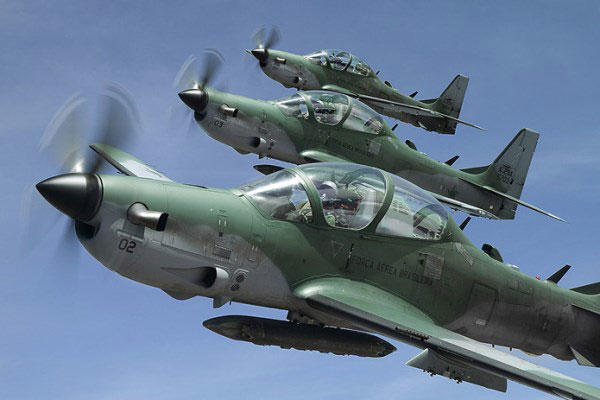After numerous delays, A-29 Super Tucano attack aircraft and the crews trained in the U.S. to fly them will finally begin arriving in Afghanistan next year to give fixed-wing ground attack capability to the struggling air component of the Afghan National Security Forces, according to the Pentagon.
"We wish we had started earlier," Defense Secretary Ashton Carter said in Afghanistan earlier this month, but deliveries are now being scheduled and "will be completed over the next year or so."
In the most recent setback, two Afghans in the pilot training program at Moody Air Force Base near Valdosta, Georgia, went missing on Dec. 8 just before they were to graduate. The two were initially reported to be pilot trainees, but Staff Sgt. Eric Summers, a spokesman at Moody, said last week that they were maintenance personnel.
The two -- Mirwais Kohistani and Shirzad Rohullah -- were still missing as of Monday.
"We are actively working to locate these two individuals in coordination with the State Department and the Department of Defense," said Bryan Cox, a spokesman for Immigration and Customs Enforcement in Atlanta.
"We have no information to lead us to believe at this time that they pose any specific threat," he added. "We are examining a variety of electronic and physical information and following those leads where they take us."
The two were training with the 81st Fighter Squadron at Moody, which graduated nine Afghan pilots from the training program on Dec. 18.
At the graduation ceremony, Col. John Nichols, the 14th Flying Training Wing Commander, said, "The extraordinary dedication of these pilots and the sacrifices these graduates have made will help establish a secure, stable and unified country," according to an Air Force release.
The graduates, who began training last February, will carry out a "vitally important mission" which "simply stated is to help build the future of Afghanistan. This graduation marks the first step in this monumental undertaking," Nichols said.
Maj. Gen. James Hecker, the 19th Air Force commander, sand pilot training normally takes two to three years, "depending on which aircraft they are going to but they (the Afghans) had to push it up because they need to get over there and get in the fight."
The nine Afghan pilots were to be the first of 30 who will be trained at Moody over the next three years with the Super Tucanos.
The Air Force has been working to get a fixed-wing attack aircraft to the Afghan Air Force since at least 2011. In 2012, a $428 million contract was awarded to the Brazilian company Embraer S.A. and its American partner, the Sierra Nevada Corp., for 20 A-29 single-engine turboprops with an option for another 20, but the award was challenged by Beechcraft Corp.
Beechcraft had offered its AT-6B Texan II for the close air support mission. In 2013, the A-29 again won an Air Force fly off against the AT-6B Texan II and Embraer again secured the contract.
The Super Tucanos carry two 12.7-mm machine guns in the wings, and they can be configured with underwing weapons, including additional 12.7-mm machine guns, rockets pods and precision-guided or "dumb" bombs.
About eight of the A-29s were expected to begin arriving in Afghanistan next year, possibly as early as January, to replace the Afghan Air Force's Russian-made Mi-35 "Hind" helicopters for close air support. However, Afghanistan officials in October said they were negotiating with Russia for more Mi-35s.
The A-29s would also bolster the Afghan Air Force's machine gun and rocket-equipped Mi-17 "'Hip" and U.S.-made MD 530F Cayuse Warrior helicopters in the ground attack role.
The capabilities and ease of maintenance of the A-29s have made the prop aircraft the choice of low-budget air forces worldwide, both for surveillance and ground attack, according to the trade publication Defense Industry Daily.
The A-29, also known as the EMB-314, has been picking up global orders in Africa, including commitments in Ghana, Angola, Burkina Faso, Mauritania and Senegal. Brazil, Chile, Colombia, the Dominican Republic, Ecuador, Guatemala and Indonesia also are A-29 customers.
On Dec. 18, the same day that the Afghan pilots were graduating at Moody, Defense Secretary Ashton Carter was in Afghanistan for meetings with acting Afghan Defense Minister Masoom Stanikzai.
Carter said that "in the next few months the Afghan Air Force will start to take off with greater firepower into the air" when the A-29s arrive. He said that the aircraft "will be a key element to increasing the superiority of Afghan forces over Taliban forces."
"The future for Afghanistan that we're building together is one where they have their own air forces," he said. "That's why the importance of the delivery of the A-29 here is so important."
The two maintenance personnel who went missing from Moody were not the first Afghans to walk away from a training program in the U.S.
In Sept. 2014, three Afghan National Army officers -- Maj. Jan Mohammad Arash, Capt. Mohammad Nasir Askarzada and Capt. Noorullah Aminy – disappeared from a trip to a shopping mall on Cape Cod, Massachusetts. The three were in a training program at a National Guard facility at Joint Base Cape Cod.
After a $1,200 cab ride to Niagara Falls, New York, the three were picked up by Canadian border guards as they tried to cross into Canada. One of the three reportedly was granted asylum in the U.S. while the other two were deported to Afghanistan.
--Richard Sisk can be reached at Richard.Sisk@military.com.




























